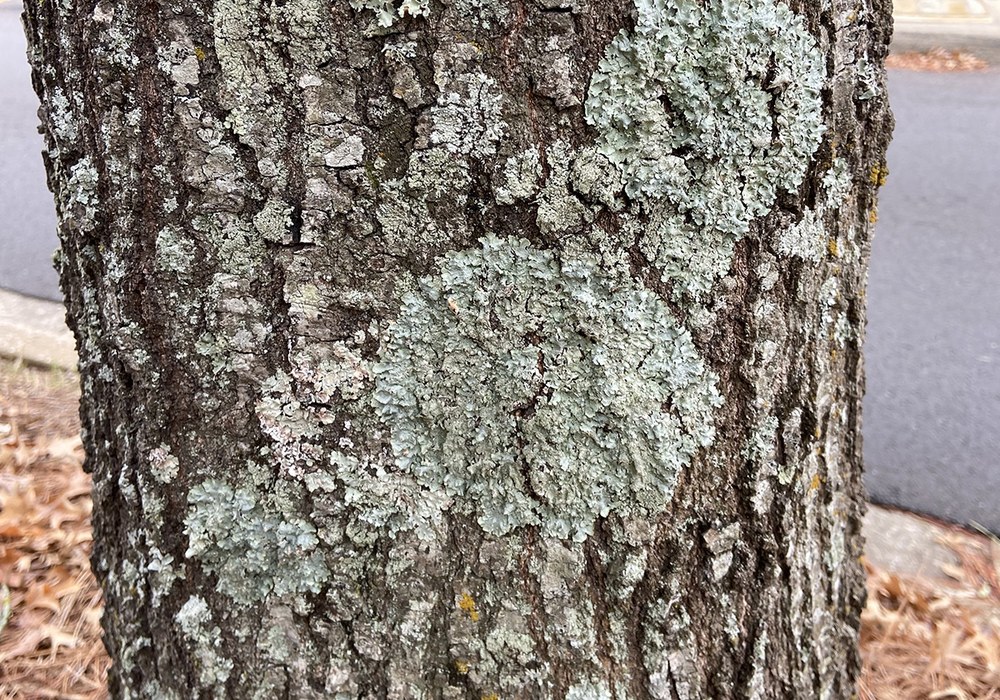Posted: February 10, 2025
Lichens are not plants; they are a symbiotic combination of multiple species.

Green lichens present on tree trunk.
As trees drop their leaves each autumn, their bark takes on more prominence in the landscape. It is not uncommon for a question or two to the Penn State Extension Garden Hotline to follow: "What is the strange-looking growth on my tree trunks, and how can I get rid of it?" Chances are, that growth is lichen.
Lichens are not plants. They are a symbiotic combination of multiple species, a unique organism that results when a fungus and some alga or specialized bacterium partner. The fungus forms the outer layer, or thallus, of the lichen, and the algae and/or bacteria live inside, providing nutrients through photosynthesis. Lichens receive everything else they need to live and grow from the atmosphere. Their growth rate depends on the availability of moisture and sunlight, and temperature levels. Generally, the more light they receive while wet, the faster they grow.
Lichens are found almost everywhere on Earth; more than 36,000 species have been identified in North America alone. Although lichens can grow on almost any surface, they are most often noticed in our region when growing on trees. They prefer older trees with ridged bark that they can easily cling to or those that are stressed or declining due to poor drainage, too much or too little water, or suffering from damage by insects or disease.
The presence of lichens on young, small trees can be a signal of one or more stressors, particularly if they are present in the tree’s canopy. So while lichens can be an indicator of poor tree health, they are never the cause. In fact, they have a number of benefits.
Lichens are very sensitive to air pollution. Their presence is a sign that the local environment is clean enough to support them, which is one reason that they are less common in urban areas. Lichens can be used to monitor levels of pollutants such as acid rain, ammonia, metals, and even radioactive particles from nuclear accidents.
In arctic regions, where lichens are a dominant species, they play a part in slowing global warming by consuming carbon dioxide in the process of photosynthesis. In dense forests, some lichen species grow high in the tree canopy to take advantage of light. They release nitrogen and phosphorus, two nutrients vital for tree growth. Lichens also capture fog and dew, playing a part in conserving moisture in dry regions and preventing soils from drying out.
Various cultures have used lichens for medicines, perfumes, dyes, and even food since very few are poisonous. They are the most important food source for animals such as caribou and flying squirrels, and they are also eaten by deer, moose, and voles. Some types of lichens provide nesting material for birds.
Chemical activity within lichens results in a range of brightly colored species. They exhibit a wide variety of forms, from hard and crusty to long, stringy strands or plant or shrub-like. Some species are easily mistaken for mosses. Common greenshield lichens (Flavoparmelia spp.) are one of the most widespread in eastern North America. These species are the type typically seen growing on the bark of local hardwood trees and rocks. Greenshield lichens are named for their pale yellow-green color. They typically grow outward from a central point, often in concentric circular patterns, with a branching structure and rounded lobes arranged as flat, loosely attached patches.
Ultimately, beauty is in the eye of the beholder. But whether or not you appreciate the uniquely beautiful shapes, textures, and colors of lichens or the interesting character they lend to trees and shrubs, removing them from your tree trunks is not recommended. Lichens have no roots and are not connected in any way to the tree's vascular system, so they take no water or nutrients from the tree. Attempting to remove lichen from living trees by scraping or scrubbing can permanently damage the bark. Bark functions as the tree's protective outer layer and a break in that barrier can allow insect pests or diseases to get inside.
Questions on lichens are common during our winter season. As the year progresses, local gardeners can get answers to many garden-related questions or problems via the Penn State Master Gardener Hotline. Volunteers are available to provide answers and advice based on current, research-based information. Contact the Garden Hotline by email at alleghenymg@psu.edu or by phone at 412-482-3476. The Hotline is staffed weekly in January and February, and Monday to Thursday from 9 A.M. to 1 P.M. throughout the growing season, beginning in March.
Maureen Karl is a Penn State Master Gardener. This volunteer program supports the outreach mission of Penn State Extension and provides research-based information on best practices in sustainable horticulture and environmental stewardship. For more information, contact the Penn State Extension of Allegheny County at alleghenymg@psu.edu or 412-482-3476

